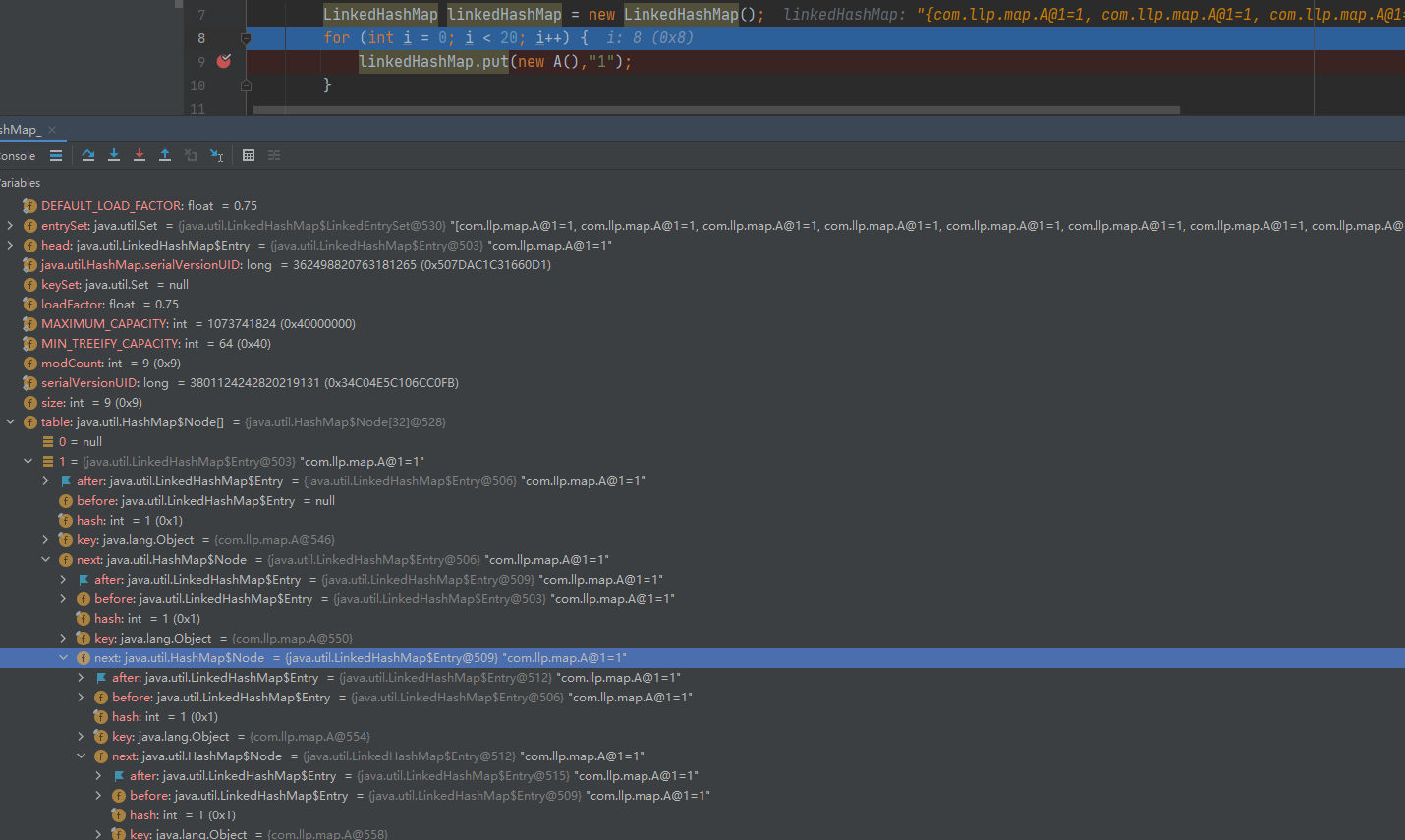集合
集合
1.集合的理解和好处
1.1数组

1.2集合

2.集合的框架体系
Java 的集合类很多,主要分为两大类:单列集合,双列集合
单列集合

双列集合

public static void main(String[] args) {
//老韩解读
//1. 集合主要是两组(单列集合 , 双列集合)
//2. Collection 接口有两个重要的子接口 List Set , 他们的实现子类都是单列集合
//3. Map 接口的实现子类 是双列集合,存放的 K-V
//4. 把老师梳理的两张图记住
//Collection
//Map
ArrayList arrayList = new ArrayList();
arrayList.add("jack");
arrayList.add("tom");
HashMap hashMap = new HashMap();
hashMap.put("NO1", "北京");
hashMap.put("NO2", "上海");
}
3. Collection 接口和常用方法

3.1Collection接口实现类的特点

Collection 接口常用方法,以实现子类 ArrayList 来演示. CollectionMethod.java
public class CollectionMethod {
@SuppressWarnings({"all"})
public static void main(String[] args) {
List list = new ArrayList();
// add:添加单个元素
list.add("jack");
list.add(10);//list.add(new Integer(10))
list.add(true);
System.out.println("list=" + list);
// remove:删除指定元素
//list.remove(0);//删除第一个元素
list.remove(true);//指定删除某个元素
System.out.println("list=" + list);
// contains:查找元素是否存在
System.out.println(list.contains("jack"));//T
// size:获取元素个数
System.out.println(list.size());//2
// isEmpty:判断是否为空
System.out.println(list.isEmpty());//F
// clear:清空
list.clear();
System.out.println("list=" + list);
// addAll:添加多个元素
ArrayList list2 = new ArrayList();
list2.add("红楼梦");
list2.add("三国演义");
list.addAll(list2);
System.out.println("list=" + list);
// containsAll:查找多个元素是否都存在
System.out.println(list.containsAll(list2));//T
// removeAll:删除多个元素
list.add("聊斋");
list.removeAll(list2);
System.out.println("list=" + list);//[聊斋]
// 说明:以ArrayList实现类来演示.
}
}
3.2collection接口遍历元素方式 1-使用Iterator(迭代器)




//1. 先得到 col 对应的 迭代器
Iterator iterator = col.iterator();
//2. 使用while循环遍历
// while (iterator.hasNext()) {//判断是否还有数据
// //返回下一个元素,类型是Object
// Object obj = iterator.next();
// System.out.println("obj=" + obj);
// }
//快捷键,快速生成itit
//显示所有的快捷键的的快捷键 ctrl + j
while (iterator.hasNext()) {
Object obj = iterator.next();
System.out.println("obj=" + obj);
}
//3. 当退出while循环后 , 这时iterator迭代器,指向最后的元素
// iterator.next();//NoSuchElementException
//4. 如果希望再次遍历,需要重置我们的迭代器
iterator = col.iterator();
System.out.println("===第二次遍历===");
while (iterator.hasNext()) {
Object obj = iterator.next();
System.out.println("obj=" + obj);
}
3.3Collection 接口遍历对象方式 2-for 循环增强



3.4List的三种遍历方式 [ArrayList, LinkedList,Vector]

//遍历
//1. 迭代器
Iterator iterator = list.iterator();
while (iterator.hasNext()) {
Object obj = iterator.next();
System.out.println(obj);
}
System.out.println("=====增强for=====");
//2. 增强for
for (Object o : list) {
System.out.println("o=" + o);
}
System.out.println("=====普通for====");
//3. 使用普通for
for (int i = 0; i < list.size(); i++) {
System.out.println("对象=" + list.get(i));
}
//等同于 增强for
list.forEach(o -> {
System.out.println(o);
});
4. ArrayList 底层结构和源码分析
4.1ArrayList的注意事项


4.2 ArrayList 的底层操作机制源码分析(重点,难点.)

public class ArrayListSource {
public static void main(String[] args) {
//老韩解读源码
//注意,注意,注意,Idea 默认情况下,Debug 显示的数据是简化后的,如果希望看到完整的数据
//需要做设置.
//使用无参构造器创建ArrayList对象
//ArrayList list = new ArrayList();
ArrayList list = new ArrayList(8);
//使用for给list集合添加 1-10数据
for (int i = 1; i <= 10; i++) {
list.add(i);
}
//使用for给list集合添加 11-15数据
for (int i = 11; i <= 15; i++) {
list.add(i);
}
list.add(100);
list.add(200);
list.add(null);
}
}
可以看到当创建集合时,如果指定了长度则已指定长度来创建指定长度的数组,如果没有则创建一个空数组
transient 短暂的,修饰的字段不能被序列化




5.Vector 底层结构和源码剖析
5.1Vector 的基本介绍

5.2Vector 和ArrayList 的比较

Vector扩容

6. LinkedList底层结构
6.1LinkedList的全面说明

6.2LinkedList 的底层操作机制

public class LinkedList01 {
public static void main(String[] args) {
//模拟一个简单的双向链表
Node jack = new Node("jack");
Node tom = new Node("tom");
Node hsp = new Node("老韩");
//连接三个结点,形成双向链表
//jack -> tom -> hsp
jack.next = tom;
tom.next = hsp;
//hsp -> tom -> jack
hsp.pre = tom;
tom.pre = jack;
Node first = jack;//让first引用指向jack,就是双向链表的头结点
Node last = hsp; //让last引用指向hsp,就是双向链表的尾结点
//演示,从头到尾进行遍历
System.out.println("===从头到尾进行遍历===");
while (true) {
if(first == null) {
break;
}
//输出first 信息
System.out.println(first);
first = first.next;
}
//演示,从尾到头的遍历
System.out.println("====从尾到头的遍历====");
while (true) {
if(last == null) {
break;
}
//输出last 信息
System.out.println(last);
last = last.pre;
}
//演示链表的添加对象/数据,是多么的方便
//要求,是在 tom --------- 老韩直接,插入一个对象 smith
//1. 先创建一个 Node 结点,name 就是 smith
Node smith = new Node("smith");
//下面就把 smith 加入到双向链表了
smith.next = hsp;
smith.pre = tom;
hsp.pre = smith;
tom.next = smith;
//让first 再次指向jack
first = jack;//让first引用指向jack,就是双向链表的头结点
System.out.println("===从头到尾进行遍历===");
while (true) {
if(first == null) {
break;
}
//输出first 信息
System.out.println(first);
first = first.next;
}
last = hsp; //让last 重新指向最后一个结点
//演示,从尾到头的遍历
System.out.println("====从尾到头的遍历====");
while (true) {
if(last == null) {
break;
}
//输出last 信息
System.out.println(last);
last = last.pre;
}
}
}
//定义一个Node 类,Node 对象 表示双向链表的一个结点
class Node {
public Object item; //真正存放数据
public Node next; //指向后一个结点
public Node pre; //指向前一个结点
public Node(Object name) {
this.item = name;
}
public String toString() {
return "Node name=" + item;
}
}
6.3LinkedList的增删改查
@SuppressWarnings({"all"})
public class LinkedListCRUD {
public static void main(String[] args) {
LinkedList linkedList = new LinkedList();
linkedList.add(1);
linkedList.add(2);
linkedList.add(3);
System.out.println("linkedList=" + linkedList);
//演示一个删除结点的
linkedList.remove(); // 这里默认删除的是第一个结点
//linkedList.remove(2);
System.out.println("linkedList=" + linkedList);
//修改某个结点对象
linkedList.set(1, 999);
System.out.println("linkedList=" + linkedList);
//得到某个结点对象
//get(1) 是得到双向链表的第二个对象
Object o = linkedList.get(1);
System.out.println(o);//999
//因为LinkedList 是 实现了List接口, 遍历方式
System.out.println("===LinkeList遍历迭代器====");
Iterator iterator = linkedList.iterator();
while (iterator.hasNext()) {
Object next = iterator.next();
System.out.println("next=" + next);
}
System.out.println("===LinkeList遍历增强for====");
for (Object o1 : linkedList) {
System.out.println("o1=" + o1);
}
System.out.println("===LinkeList遍历普通for====");
for (int i = 0; i < linkedList.size(); i++) {
System.out.println(linkedList.get(i));
}
//老韩源码阅读.
/* 1. LinkedList linkedList = new LinkedList();
public LinkedList() {}
2. 这时 linkeList 的属性 first = null last = null
3. 执行 添加
public boolean add(E e) {
linkLast(e);
return true;
}
4.将新的结点,加入到双向链表的最后
void linkLast(E e) {
final Node<E> l = last;
final Node<E> newNode = new Node<>(l, e, null);
last = newNode;
if (l == null)
first = newNode;
else
l.next = newNode;
size++;
modCount++;
}
*/
/*
老韩读源码 linkedList.remove(); // 这里默认删除的是第一个结点
1. 执行 removeFirst
public E remove() {
return removeFirst();
}
2. 执行
public E removeFirst() {
final Node<E> f = first;
if (f == null)
throw new NoSuchElementException();
return unlinkFirst(f);
}
3. 执行 unlinkFirst, 将 f 指向的双向链表的第一个结点拿掉
private E unlinkFirst(Node<E> f) {
// assert f == first && f != null;
final E element = f.item;
final Node<E> next = f.next;
f.item = null;
f.next = null; // help GC
first = next;
if (next == null)
last = null;
else
next.prev = null;
size--;
modCount++;
return element;
}
*/
}
}
6.4 LinkedList和ArrayList比较

LinkedList linkedList = new LinkedList();
linkedList.add("1");
linkedList.add("2");
linkedList.add("3");
linkedList.add("3");
System.out.println(linkedList);
LinkedList在添加元素时会创建一个Node对象,通过改变next和prev的来构建双向链路


7.Set 接口和常用方法
7.1Set 接口基本介绍

和 List 接口一样, Set 接口也是 Collection 的子接口,因此,常用方法和 Collection 接口一样.
7.2 Set 接口的遍历方式

7.3 Set接口的实现类HashSet

//1. 构造器走的源码
/*
public HashSet() {
map = new HashMap<>();
}
2. HashSet 可以存放null ,但是只能有一个null,即元素不能重复
*/
Set hashSet = new HashSet();
hashSet.add(null);
hashSet.add(null);
System.out.println("hashSet=" + hashSet);
1.HashSet的底层机制



下面的示例中当一条链表的元素超过8时,会对table数组进行扩容,第一次扩容到32第二次扩容到64,之后就会转行为进行树化
public class HashSetIncrement {
public static void main(String[] args) {
/*
HashSet底层是HashMap, 第一次添加时,table 数组扩容到 16,
临界值(threshold)是 16*加载因子(loadFactor)是0.75 = 12
如果table 数组使用到了临界值 12,就会扩容到 16 * 2 = 32,
新的临界值就是 32*0.75 = 24, 依次类推
*/
HashSet hashSet = new HashSet();
// for(int i = 1; i <= 100; i++) {
// hashSet.add(i);//1,2,3,4,5...100
// }
/*
在Java8中, 如果一条链表的元素个数到达 TREEIFY_THRESHOLD(默认是 8 ),
并且table的大小 >= MIN_TREEIFY_CAPACITY(默认64),就会进行树化(红黑树),
否则仍然采用数组扩容机制
*/
for(int i = 1; i <= 12; i++) {
hashSet.add(new A(i));//
}
}
}
class A {
private int n;
public A(int n) {
this.n = n;
}
@Override
public int hashCode() {
return 100;
}
}

进行数化之后变成了HashMap$TreeNode对象

public class HashSetSource {
public static void main(String[] args) {
HashSet hashSet = new HashSet();
hashSet.add("java");//到此位置,第1次add分析完毕.
hashSet.add("php");//到此位置,第2次add分析完毕
hashSet.add("java");
System.out.println("set=" + hashSet);
/*
老韩对HashSet 的源码解读
1. 执行 HashSet()
public HashSet() {
map = new HashMap<>();
}
2. 执行 add()
public boolean add(E e) {//e = "java"
return map.put(e, PRESENT)==null;//(static) PRESENT = new Object();
}
3.执行 put() , 该方法会执行 hash(key) 得到key对应的hash值 算法h = key.hashCode()) ^ (h >>> 16)
public V put(K key, V value) {//key = "java" value = PRESENT 共享
return putVal(hash(key), key, value, false, true);
}
4.执行 putVal
final V putVal(int hash, K key, V value, boolean onlyIfAbsent,
boolean evict) {
Node<K,V>[] tab; Node<K,V> p; int n, i; //定义了辅助变量
//table 就是 HashMap 的一个数组,类型是 Node[]
//if 语句表示如果当前table 是null, 或者 大小=0
//就是第一次扩容,到16个空间.
if ((tab = table) == null || (n = tab.length) == 0)
n = (tab = resize()).length;
//(1)根据key,得到hash 去计算该key应该存放到table表的哪个索引位置
//并把这个位置的对象,赋给 p
//(2)判断p 是否为null
//(2.1) 如果p 为null, 表示还没有存放元素, 就创建一个Node (key="java",value=PRESENT)
//(2.2) 就放在该位置 tab[i] = newNode(hash, key, value, null)
if ((p = tab[i = (n - 1) & hash]) == null)
tab[i] = newNode(hash, key, value, null);
else {
//一个开发技巧提示: 在需要局部变量(辅助变量)时候,在创建
Node<K,V> e; K k; //
//如果当前索引位置对应的链表的第一个元素和准备添加的key的hash值一样
//并且满足 下面两个条件之一:
//(1) 准备加入的key 和 p 指向的Node 结点的 key 是同一个对象
//(2) p 指向的Node 结点的 key 的equals() 和准备加入的key比较后相同
//就不能加入
if (p.hash == hash &&
((k = p.key) == key || (key != null && key.equals(k))))
e = p;
//再判断 p 是不是一颗红黑树,
//如果是一颗红黑树,就调用 putTreeVal , 来进行添加
else if (p instanceof TreeNode)
e = ((TreeNode<K,V>)p).putTreeVal(this, tab, hash, key, value);
else {//如果table对应索引位置,已经是一个链表, 就使用for循环比较
//(1) 依次和该链表的每一个元素比较后,都不相同, 则加入到该链表的最后
// 注意在把元素添加到链表后,立即判断 该链表是否已经达到8个结点
// , 就调用 treeifyBin() 对当前这个链表进行树化(转成红黑树)
// 注意,在转成红黑树时,要进行判断, 判断条件
// if (tab == null || (n = tab.length) < MIN_TREEIFY_CAPACITY(64))
// resize();
// 如果上面条件成立,先table扩容.
// 只有上面条件不成立时,才进行转成红黑树
//(2) 依次和该链表的每一个元素比较过程中,如果有相同情况,就直接break
for (int binCount = 0; ; ++binCount) {
if ((e = p.next) == null) {
p.next = newNode(hash, key, value, null);
if (binCount >= TREEIFY_THRESHOLD(8) - 1) // -1 for 1st
treeifyBin(tab, hash);
break;
}
if (e.hash == hash &&
((k = e.key) == key || (key != null && key.equals(k))))
break;
p = e;
}
}
if (e != null) { // existing mapping for key
V oldValue = e.value;
if (!onlyIfAbsent || oldValue == null)
e.value = value;
afterNodeAccess(e);
return oldValue;
}
}
++modCount;
//size 就是我们每加入一个结点Node(k,v,h,next), size++
if (++size > threshold)
resize();//扩容
afterNodeInsertion(evict);
return null;
}
*/
}
}
7.4 Set 接口实现类-LinkedHashSet

注意LinkedHashSet底层是双向链表+数组 维护元素的次序
HashSet底层是单向链表+数组,添加的元素是无序的


7.5 Set接口实现类TreeSet
TreeSet 提供的一个构造器,可以传入一个比较器(匿名内部类)并指定排序规则
public class TreeSet_ {
public static void main(String[] args) {
//老韩解读
//1. 当我们使用无参构造器,创建TreeSet时,仍然是无序的
//2. 老师希望添加的元素,按照字符串大小来排序
//3. 使用TreeSet 提供的一个构造器,可以传入一个比较器(匿名内部类)
// 并指定排序规则
//4. 简单看看源码
//老韩解读
/*
1. 构造器把传入的比较器对象,赋给了 TreeSet的底层的 TreeMap的属性this.comparator
public TreeMap(Comparator<? super K> comparator) {
this.comparator = comparator;
}
2. 在 调用 treeSet.add("tom"), 在底层会执行到
if (cpr != null) {//cpr 就是我们的匿名内部类(对象)
do {
parent = t;
//动态绑定到我们的匿名内部类(对象)compare
cmp = cpr.compare(key, t.key);
if (cmp < 0)
t = t.left;
else if (cmp > 0)
t = t.right;
else //如果相等,即返回0,这个Key就没有加入
return t.setValue(value);
} while (t != null);
}
*/
// TreeSet treeSet = new TreeSet();
TreeSet treeSet = new TreeSet(new Comparator() {
@Override
public int compare(Object o1, Object o2) {
//下面 调用String的 compareTo方法进行字符串大小比较
//如果老韩要求加入的元素,按照长度大小排序
//return ((String) o2).compareTo((String) o1);
return ((String) o1).length() - ((String) o2).length();
}
});
//添加数据.
treeSet.add("jack");
treeSet.add("tom");//3
treeSet.add("sp");
treeSet.add("a");
treeSet.add("abc");//3
System.out.println("treeSet=" + treeSet);
}
}
8. Map 接口和常用方法
8.1.Map 接口和常用方法


@SuppressWarnings({"all"})
public class Map_ {
public static void main(String[] args) {
//老韩解读Map 接口实现类的特点, 使用实现类HashMap
//1. Map与Collection并列存在。用于保存具有映射关系的数据:Key-Value(双列元素)
//2. Map 中的 key 和 value 可以是任何引用类型的数据,会封装到HashMap$Node 对象中
//3. Map 中的 key 不允许重复,原因和HashSet 一样,前面分析过源码.
//4. Map 中的 value 可以重复
//5. Map 的key 可以为 null, value 也可以为null ,注意 key 为null,
// 只能有一个,value 为null ,可以多个
//6. 常用String类作为Map的 key
//7. key 和 value 之间存在单向一对一关系,即通过指定的 key 总能找到对应的 value
Map map = new HashMap();
map.put("no1", "韩顺平");//k-v
map.put("no2", "张无忌");//k-v
map.put("no1", "张三丰");//当有相同的k , 就等价于替换.
map.put("no3", "张三丰");//k-v
map.put(null, null); //k-v
map.put(null, "abc"); //等价替换
map.put("no4", null); //k-v
map.put("no5", null); //k-v
map.put(1, "赵敏");//k-v
map.put(new Object(), "金毛狮王");//k-v
// 通过get 方法,传入 key ,会返回对应的value
System.out.println(map.get("no2"));//张无忌
System.out.println("map=" + map);
}
}
8.2 Map接口实现类-HashMap

无序性
Map map2 = new HashMap();
map2.put("12",2);
map2.put("sa",3);
map2.put("aas",4);
System.out.println(map2);
//输出
{12=2, aas=4, sa=3}
1.HashMap的底层机制

@SuppressWarnings({"all"})
public class HashMapSource1 {
public static void main(String[] args) {
HashMap map = new HashMap();
map.put("java", 10);//ok
map.put("php", 10);//ok
map.put("java", 20);//替换value
System.out.println("map=" + map);//
/*老韩解读HashMap的源码+图解
1. 执行构造器 new HashMap()
初始化加载因子 loadfactor = 0.75
HashMap$Node[] table = null
2. 执行put 调用 hash方法,计算 key的 hash值 (h = key.hashCode()) ^ (h >>> 16)
public V put(K key, V value) {//K = "java" value = 10
return putVal(hash(key), key, value, false, true);
}
3. 执行 putVal
final V putVal(int hash, K key, V value, boolean onlyIfAbsent,
boolean evict) {
Node<K,V>[] tab; Node<K,V> p; int n, i;//辅助变量
//如果底层的table 数组为null, 或者 length =0 , 就扩容到16
if ((tab = table) == null || (n = tab.length) == 0)
n = (tab = resize()).length;
//取出hash值对应的table的索引位置的Node, 如果为null, 就直接把加入的k-v
//, 创建成一个 Node ,加入该位置即可
if ((p = tab[i = (n - 1) & hash]) == null)
tab[i] = newNode(hash, key, value, null);
else {
Node<K,V> e; K k;//辅助变量
// 如果table的索引位置的key的hash相同和新的key的hash值相同,
// 并 满足(table现有的结点的key和准备添加的key是同一个对象 || equals返回真)
// 就认为不能加入新的k-v
if (p.hash == hash &&
((k = p.key) == key || (key != null && key.equals(k))))
e = p;
else if (p instanceof TreeNode)//如果当前的table的已有的Node 是红黑树,就按照红黑树的方式处理
e = ((TreeNode<K,V>)p).putTreeVal(this, tab, hash, key, value);
else {
//如果找到的结点,后面是链表,就循环比较
for (int binCount = 0; ; ++binCount) {//死循环
if ((e = p.next) == null) {//如果整个链表,没有和他相同,就加到该链表的最后
p.next = newNode(hash, key, value, null);
//加入后,判断当前链表的个数,是否已经到8个,到8个,后
//就调用 treeifyBin 方法进行红黑树的转换
if (binCount >= TREEIFY_THRESHOLD - 1) // -1 for 1st
treeifyBin(tab, hash);
break;
}
if (e.hash == hash && //如果在循环比较过程中,发现有相同,就break,就只是替换value
((k = e.key) == key || (key != null && key.equals(k))))
break;
p = e;
}
}
if (e != null) { // existing mapping for key
V oldValue = e.value;
if (!onlyIfAbsent || oldValue == null)
e.value = value; //替换,key对应value
afterNodeAccess(e);
return oldValue;
}
}
++modCount;//每增加一个Node ,就size++
if (++size > threshold[12-24-48])//如size > 临界值,就扩容
resize();
afterNodeInsertion(evict);
return null;
}
5. 关于树化(转成红黑树)
//如果table 为null ,或者大小还没有到 64,暂时不树化,而是进行扩容.
//否则才会真正的树化 -> 剪枝
final void treeifyBin(Node<K,V>[] tab, int hash) {
int n, index; Node<K,V> e;
if (tab == null || (n = tab.length) < MIN_TREEIFY_CAPACITY)
resize();
}
*/
}
}
2.模拟HashMap链表树化
public class MyTest {
public static void main(String[] args) {
Map map = new HashMap();
for (int i = 0; i < 10; i++) {
map.put(new A(),"1");
}
}
}
class A{
@Override
public int hashCode() {
return 100;
}
}
//输出结果
{com.llp.file.A@64=1, com.llp.file.A@64=1, com.llp.file.A@64=1, com.llp.file.A@64=1, com.llp.file.A@64=1, com.llp.file.A@64=1, com.llp.file.A@64=1, com.llp.file.A@64=1, com.llp.file.A@64=1, com.llp.file.A@64=1}
HashMap底层由数组和单向链表组成

8.3 Map 接口实现类-Hashtable

1. Hashtable和HashMap的比较

2.Hashtable底层机制
public Hashtable(int initialCapacity, float loadFactor) {
if (initialCapacity < 0)
throw new IllegalArgumentException("Illegal Capacity: "+
initialCapacity);
if (loadFactor <= 0 || Float.isNaN(loadFactor))
throw new IllegalArgumentException("Illegal Load: "+loadFactor);
if (initialCapacity==0)
initialCapacity = 1;
this.loadFactor = loadFactor;
table = new Entry<?,?>[initialCapacity];
threshold = (int)Math.min(initialCapacity * loadFactor, MAX_ARRAY_SIZE + 1);
}
public class HashTableExercise {
public static void main(String[] args) {
Hashtable table = new Hashtable();//ok
table.put("john", 100); //ok
//table.put(null, 100); //异常 NullPointerException
//table.put("john", null);//异常 NullPointerException
table.put("lucy", 100);//ok
table.put("lic", 100);//ok
table.put("lic", 88);//替换
table.put("hello1", 1);
table.put("hello2", 1);
table.put("hello3", 1);
table.put("hello4", 1);
table.put("hello5", 1);
table.put("hello6", 1);
System.out.println(table);
//简单说明一下Hashtable的底层
//1. 底层有数组 Hashtable$Entry[] 初始化大小为 11
//2. 临界值 threshold 8 = 11 * 0.75
//3. 扩容: 按照自己的扩容机制来进行即可.
//4. 执行 方法 addEntry(hash, key, value, index); 添加K-V 封装到Entry
//5. 当 if (count >= threshold) 满足时,就进行扩容
//5. 按照 int newCapacity = (oldCapacity << 1) + 1; 的大小扩容.
}
}
8.4 Map 接口实现类-Properties

读取文件
public class Properties02 {
public static void main(String[] args) throws IOException {
//使用Properties 类来读取mysql.properties 文件
//1. 创建Properties 对象
Properties properties = new Properties();
//2. 加载指定配置文件
properties.load(new FileReader("src\\mysql.properties"));
//3. 把k-v显示控制台
properties.list(System.out);
//4. 根据key 获取对应的值
String user = properties.getProperty("user");
String pwd = properties.getProperty("pwd");
System.out.println("用户名=" + user);
System.out.println("密码是=" + pwd);
}
}
特点
public class Properties_ {
public static void main(String[] args) {
//老韩解读
//1. Properties 继承 Hashtable
//2. 可以通过 k-v 存放数据,当然key 和 value 不能为 null
//增加
Properties properties = new Properties();
//properties.put(null, "abc");//抛出 空指针异常
//properties.put("abc", null); //抛出 空指针异常
properties.put("john", 100);//k-v
properties.put("lucy", 100);
properties.put("lic", 100);
properties.put("lic", 88);//如果有相同的key , value被替换
System.out.println("properties=" + properties);
//通过k 获取对应值
System.out.println(properties.get("lic"));//88
//删除
properties.remove("lic");
System.out.println("properties=" + properties);
//修改
properties.put("john", "约翰");
System.out.println("properties=" + properties);
}
}
原理
public class Properties03 {
public static void main(String[] args) throws IOException {
//使用Properties 类来创建 配置文件, 修改配置文件内容
Properties properties = new Properties();
//创建
//1.如果该文件没有key 就是创建
//2.如果该文件有key ,就是修改
/*
Properties 父类是 Hashtable , 底层就是Hashtable 核心方法
public synchronized V put(K key, V value) {
// Make sure the value is not null
if (value == null) {
throw new NullPointerException();
}
// Makes sure the key is not already in the hashtable.
Entry<?,?> tab[] = table;
int hash = key.hashCode();
int index = (hash & 0x7FFFFFFF) % tab.length;
@SuppressWarnings("unchecked")
Entry<K,V> entry = (Entry<K,V>)tab[index];
for(; entry != null ; entry = entry.next) {
if ((entry.hash == hash) && entry.key.equals(key)) {
V old = entry.value;
entry.value = value;//如果key 存在,就替换
return old;
}
}
addEntry(hash, key, value, index);//如果是新k, 就addEntry
return null;
}
*/
properties.setProperty("charset", "utf8");
properties.setProperty("user", "汤姆");//注意保存时,是中文的 unicode码值
properties.setProperty("pwd", "888888");
//将k-v 存储文件中即可
properties.store(new FileOutputStream("src\\mysql2.properties"), null);
System.out.println("保存配置文件成功~");
}
}
8.5 Map接口实现类-TreeMap
public class TreeMap_ {
public static void main(String[] args) {
//使用默认的构造器,创建TreeMap, 是无序的(也没有排序)
/*
老韩要求:按照传入的 k(String) 的大小进行排序
*/
// TreeMap treeMap = new TreeMap();
TreeMap treeMap = new TreeMap(new Comparator() {
@Override
public int compare(Object o1, Object o2) {
//按照传入的 k(String) 的大小进行排序
//按照K(String) 的长度大小排序
//return ((String) o2).compareTo((String) o1);
return ((String) o2).length() - ((String) o1).length();
}
});
treeMap.put("jack", "杰克");
treeMap.put("tom", "汤姆");
treeMap.put("kristina", "克瑞斯提诺");
treeMap.put("smith", "斯密斯");
treeMap.put("hsp", "韩顺平");//加入不了
System.out.println("treemap=" + treeMap);
/*
老韩解读源码:
1. 构造器. 把传入的实现了 Comparator接口的匿名内部类(对象),传给给TreeMap的comparator
public TreeMap(Comparator<? super K> comparator) {
this.comparator = comparator;
}
2. 调用put方法
2.1 第一次添加, 把k-v 封装到 Entry对象,放入root
Entry<K,V> t = root;
if (t == null) {
compare(key, key); // type (and possibly null) check
root = new Entry<>(key, value, null);
size = 1;
modCount++;
return null;
}
2.2 以后添加
Comparator<? super K> cpr = comparator;
if (cpr != null) {
do { //遍历所有的key , 给当前key找到适当位置
parent = t;
cmp = cpr.compare(key, t.key);//动态绑定到我们的匿名内部类的compare
if (cmp < 0)
t = t.left;
else if (cmp > 0)
t = t.right;
else //如果遍历过程中,发现准备添加Key 和当前已有的Key 相等,就不添加
return t.setValue(value);
} while (t != null);
}
*/
}
}
8.6 Map接口实现类LinkedHashMap
1.LinkedHashMap组成及扩容机制
(1)LinkedHashMap底层由数组、双向链表、红黑树构成; 双向链表——》具备有序性
(2)LinkedHashMap第一次添加数组长度为16
(3)如果一条链表的元素超过了8个则会对数组进行扩容,每超过一个就会扩容两倍;当数组长度扩容至64时,链表再次添加元素就会进行树化
(4)LinkedHashMap数组扩容的阈值也是16*0.75=12当数组元素超过12时就会对数组进行扩容2倍,64*0.75=48时扩容两倍 128*0.75=96 依次类推
2.LinkedHashMap的底层机制
扩容机制
LinkedHashMap数组扩容的阈值也是160.75=12当数组元素超过12时就会对数组进行扩容2倍,640.75=48时扩容两倍 128*0.75=96 依次类推

链表树化

public class LinkedHashMap_ {
public static void main(String[] args) {
LinkedHashMap linkedHashMap = new LinkedHashMap();
for (int i = 0; i < 20; i++) {
linkedHashMap.put(new A(),"1");
}
}
}
class A{
@Override
public int hashCode() {
return 1;
}
}
9.Collections 工具类
9.1.Collections 工具类介绍


这里swap i和j为集合下标

public class Collections_ {
public static void main(String[] args) {
//创建ArrayList 集合,用于测试.
List list = new ArrayList();
list.add("tom");
list.add("smith");
list.add("king");
list.add("milan");
list.add("tom");
// reverse(List):反转 List 中元素的顺序
Collections.reverse(list);
System.out.println("list=" + list);
// shuffle(List):对 List 集合元素进行随机排序
// for (int i = 0; i < 5; i++) {
// Collections.shuffle(list);
// System.out.println("list=" + list);
// }
// sort(List):根据元素的自然顺序对指定 List 集合元素按升序排序
Collections.sort(list);
System.out.println("自然排序后");
System.out.println("list=" + list);
// sort(List,Comparator):根据指定的 Comparator 产生的顺序对 List 集合元素进行排序
//我们希望按照 字符串的长度大小排序
Collections.sort(list, new Comparator() {
@Override
public int compare(Object o1, Object o2) {
//可以加入校验代码.
return ((String) o2).length() - ((String) o1).length();
}
});
System.out.println("字符串长度大小排序=" + list);
// swap(List,int, int):将指定 list 集合中的 i 处元素和 j 处元素进行交换
//比如
Collections.swap(list, 0, 1);
System.out.println("交换后的情况");
System.out.println("list=" + list);
//Object max(Collection):根据元素的自然顺序,返回给定集合中的最大元素
System.out.println("自然顺序最大元素=" + Collections.max(list));
//Object max(Collection,Comparator):根据 Comparator 指定的顺序,返回给定集合中的最大元素
//比如,我们要返回长度最大的元素
Object maxObject = Collections.max(list, new Comparator() {
@Override
public int compare(Object o1, Object o2) {
return ((String)o1).length() - ((String)o2).length();
}
});
System.out.println("长度最大的元素=" + maxObject);
//Object min(Collection)
//Object min(Collection,Comparator)
//上面的两个方法,参考max即可
//int frequency(Collection,Object):返回指定集合中指定元素的出现次数
System.out.println("tom出现的次数=" + Collections.frequency(list, "tom"));
//void copy(List dest,List src):将src中的内容复制到dest中
ArrayList dest = new ArrayList();
//为了完成一个完整拷贝,我们需要先给dest 赋值,大小和list.size()一样
for(int i = 0; i < list.size(); i++) {
dest.add("");
}
//拷贝
Collections.copy(dest, list);
System.out.println("dest=" + dest);
//boolean replaceAll(List list,Object oldVal,Object newVal):使用新值替换 List 对象的所有旧值
//如果list中,有tom 就替换成 汤姆
Collections.replaceAll(list, "tom", "汤姆");
System.out.println("list替换后=" + list);
}
}
10.总结

1.ArrayList构成及扩容机制
(1)ArrayList底层是一个Object数组elementData
(2)创建时通过无参构造创建new ArrayList()时,初始化长度为0
(3)当第一次添加时,扩容为10;当添加元素超过10时,数组将扩容1.5被10*1.5 = 15 依次类推
(4)创建时通过有参构造new ArrayList(n)创建时,初始化长度为n
(5)当长度超过n时,数组扩容1.5倍,n*1.5 依次类推
2.LinkedList构成及扩容机制
(1)LinkedList底层由双向链表构成
(2)添加、删除效率较高
3.Vector
(1)Vector底层是一个Object数组elementData
(2)创建时通过无参构造创建new Vector()时,初始化长度为0
(3)当第一次添加时,扩容为10;当添加元素超过10时,数组将扩容2倍10*2 = 20 依次类推 20*2
(4)创建时通过有参构造new Vector(n)创建时,初始化长度为n
(5)当长度超过n时,数组扩容2倍,n*2 依次类推
3.HashSet
(1)HashSet底层由数组、单向链表、红黑树构成; 单向链表——>无序性
(2)new HashSet()底层创建了new HashMap()
(3)当第一次添加元素时,数组长度由0扩容为16
(4)当长度超过阈值0.75*16=12时,数组会扩2被16*2=32,下次扩容为32*0.75=24 依次类推
(5)当一条链表元素超过8时,每添加一个元素就会让数组扩容两倍直到扩容至64,当数组长度为64时,就会进行树化HashMap$TreeNode
4.LinkedHashSet
(1)LinkedHashSet底层由数组、单向链表、红黑树构成; 双向链表——>有序性
(2)new LinkedHashSet底层由数组()底层创建了new LinkedHashMap()
(3)当第一次添加元素时,数组长度由0扩容为16
(4)当长度超过阈值0.75*16=12时,数组会扩2被16*2=32,下次扩容为32*0.75=24 依次类推
(5)当一条链表元素超过8时,每添加一个元素就会让数组扩容两倍直到扩容至64,当数组长度为64时,就会进行树化
5. TreeSet
(1)TreeSet的特点和HashSet类似
(2)TreeSet通过Comparator构造方式实现对元素进行排序

6.HashMap
(1)HashMap底层由数组、单向链表、红黑树构成; 单向链表——>无序性
(2)当第一次添加元素时,数组长度由0扩容为16
(3)当长度超过阈值0.75*16=12时,数组会扩2被16*2=32,下次扩容为32*0.75=24 依次类推
(4)当一条链表元素超过8时,每添加一个元素就会让数组扩容两倍直到扩容至64,当数组长度为64时,就会进行树化HashMap$TreeNode
7.LinkedHashMap
(1)LinkedHashMap底层由数组、双向链表、红黑树构成; 双向链表——》具备有序性
(2)LinkedHashMap第一次添加数组长度为16
(3)如果一条链表的元素超过了8个则会对数组进行扩容,每超过一个就会扩容两倍;当数组长度扩容至64时,链表再次添加元素就会进行树化
(4)LinkedHashMap数组扩容的阈值也是16*0.75=12当数组元素超过12时就会对数组进行扩容2倍,64*0.75=48时扩容两倍 128*0.75=96 依次类推
8.Hashtable
(1)Hashtable底层是Hashtable$Entry[]数组初始化长度为11
(2)当数组长度超过阈值threshold 8 = 11 * 0.75=8 时,就会对数组进行扩容 11*2+1=23 ,下次扩容23*0.75=17,23*2+1=47依次类推
 JavaSE
JavaSE
 JavaWeb
JavaWeb
 Spring
Spring
 MyBatis
MyBatis
 linux
linux
 消息队列
消息队列
 工具
工具
 片段
片段
 AI
AI
 搜索
搜索